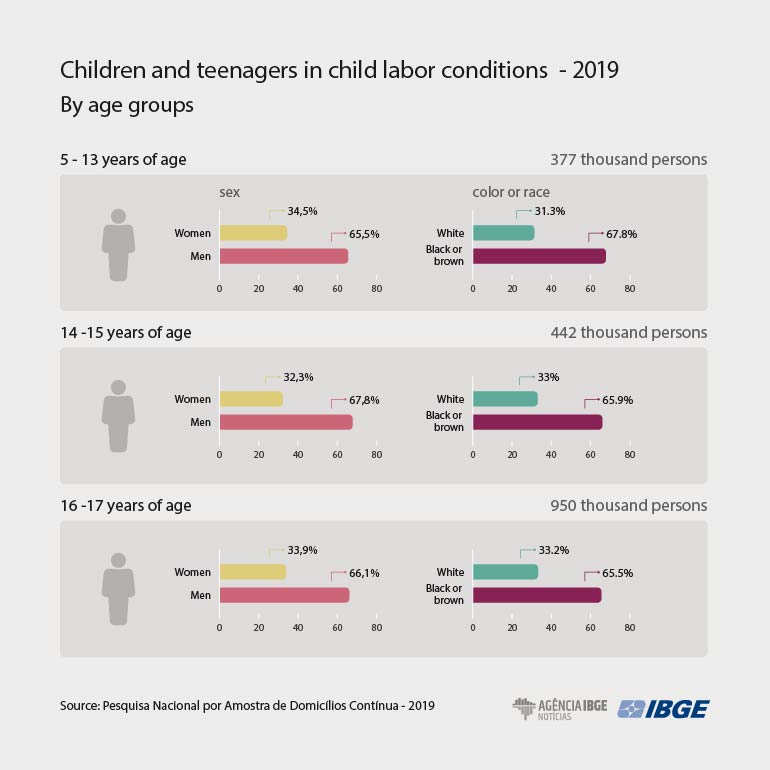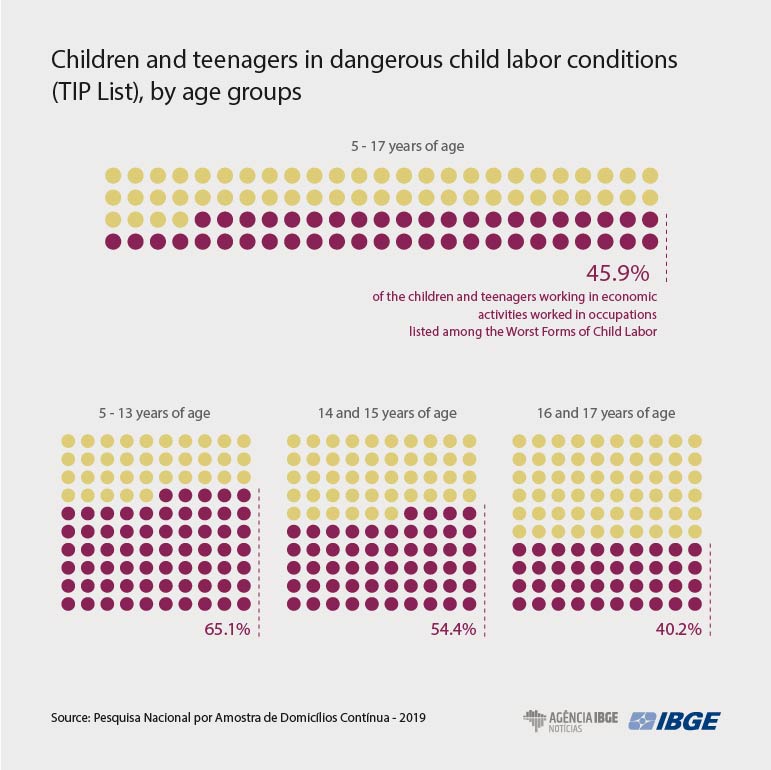Continuous PNAD
Child labor fell in 2019, but 1.8 million children were still living under such conditions
December 17, 2020 10h00 AM | Last Updated: December 21, 2020 07h33 PM
Highlights
- 1.8 million children and teenagers were living in child labor in 2019, with 1.3 million in economic activities and 463 thousand in subsistence activities.
- As for age groups, 21.3% were 5 to 13 years of age; 25.0%, 14 and 15 years of age, and the majority, 53.7%, were 16 and 17 years of age.
- Child labor affected more men (66.4%) than women (33.6%).
- The percentage of white persons living in child labor conditions was significantly lower (32.8%) than that of black or brown persons (66.1%).
- About 25% of the working youngsters aged 16 and 17 worked more than 40 hours per week.
- Women earned 87.9% of the income of men in child labor, since the average amount received by White children and teenagers was R$ 559, versus R$ 467 for black or brown persons.
- 92.7 thousand children and teenagers were domestic workers and 722 thousand aged 16 and 17 worked in informal activities.
- The survey also showed that, in 2019, there were 706 thousand persons aged 5 to 17 years of age in dangerous activities.

Child labor fell from 5.3%, in 2016, to 4.6% of the persons aged 5 to 17, in 2019. Although there was a decrease by about 357 thousand in three years, there were still 1.8 million children and teenagers in the country, with 1.3 million of them working in economic activities and 463 thousand in subsistence activities. There was a decrease of 16.8% in the number of children and teenagers living in child labor conditions from 2016, when 2.1 million children were working. Among children and teenagers engaged in economic activities, 45.9% performed dangerous activities.
Data comes from Continuous PNAD on Child and Teenage Labor, which is part of the IBGE’s experimental statistics, released today (17), and that collects information on economic, subsistence, school and domestic activities in the national territory. The survey, on an experimental basis, is mainly focused on the adoption, in 2018, of Resolution IV of the 20th International Conference of Labor Statisticians – CIET.
“Decline in child labor was observed both in absolute terms and proportionally to the population; it was slightly higher for the population of young men and boys, than among women. Such decrease was already expected, since there are more boys than girls living in child labor conditions,” says the survey manager, Maria Lucia Vieira.
Child labor profile: black and brown male youngsters aged 16 and 17
As for the age group, the overall population living in child labor conditions (1.8 million) was distributed as follows: 21.3% were between 5 to 13 years of age; 25.0%, 14 and 15, and the majority, 53.7%, were 16 or 17 years of age.
Child labor concentrated more persons of the male (66.4%) than the female sex (33.6%). The percentage of persons in child labor conditions was significantly lower (32.8%) to that of black and brown persons (66.1%).
Differences were also observed as for school attendance, since 96.6% of the population aged 5 to 17 was formed by students, whereas among child workers that estimate fell to 86.1%.

About 25% of the working youngsters aged 16 and 17 worked for more than 40 hours per week
The study shows that work shifts increased with the age of children and teenagers. Among younger children, between 5 and 13, 83.1% worked up to 14 hours per week, whereas only 25.8% of those aged 16 and 17 worked for fewer hours. Among those aged 16 and 17, 24.2% worked more than 40 hours per week.
Women received 87.7% of men’s earnings in child labor
In 2019, the average real earnings of persons 5 to 17 in child labor conditions working in economic activities was estimated at R$ 503. In terms of data disaggregated by sex, men had earnings of R$ 524, whereas women received 87.9% of that amount (R$ 461). In terms of color or race, the average amount received by white children and teenagers was R$ 559, having fallen to R$ 467 among blacks and browns.
92.7 thousand children and youngsters worked as domestic workers and 722 thousand aged 16 and 17 were in informal activities
The total 1.3 million workers performing economic activities in child labor conditions was mainly concentrated in non-agricultural activities (75.8%). They worked as domestic workers (57.7%) and auxiliary household workers (30.9%). Domestic services accounted for 7.1%, that is, 92.7 thousand were engaged in this activity.
As for employment, persons in child labor conditions were, mainly, workers in the services sector, salespersons in trade or markets (29.0%) and workers in elementary occupations (36.2%).
In the age group of 16 to 17, total workers in informal occupations was estimated at 772 thousand persons, which means informality rate of 74.1% among those engaged in economic activities in this age group.
TIP List (Dangerous Child Labor) describes 89 dangerous activities
The survey also showed that, in 2019, there were 706 thousand persons aged 5 to 17 in occupations listed under the worst forms of child labor. To reach that figure, the list of Dangerous Child Labor was combined with the occupations listed in the PNAD questionnaire.
In the groups aged 5 to 13 and 14 and 15, more than half were in risk, with 65.1% and 54.4%, respectively. Whereas 20.6% of those engaged in economic activities were working in the agricultural segment, among those in dangerous child labor occupations that percentage doubled, and reached 41.9%.
““There are 706 thousand persons in child labor conditions and in occupations from the TIP list. So 45.9% of children and teenagers working in economic activities were in dangerous child labor conditions. The profile of that population is similar to that of child labor as a whole: young men, self-declared black or brown. They work as auxiliary household workers and in the activities of agriculture and trade and repair as in child labor,” says Ms. Vieira.

The TIP list includes 89 types of work in all the economic sectors and the respective occupational risks and consequences to health. For example, children working in sawmills, and are exposed to toxic metal powder, carbon monoxide, metal fragments, and accidents with machinery and equipment that may affect their lungs or cause cuts and traumas. Or children working in the collection, separation and processing of garbage, where they are exposed to intense physical efforts and serious physical, chemical and biological risks that may lead to deformities in the spine, respiratory infections, pyoderma and dehydration.
More than half of children and youngsters do household chores and take care of persons
The survey also shows that 51.8% of the population of 38.3 million persons aged 5 to 17 in 2019, did household chores and/or took care of persons. There were a total 19.8 million persons helping in household chores or taking care of children and teenagers.
The group aged 16 and 17 had the biggest percentage of those tasks (76.9%), followed by persons aged 14 and 15 (74.8%). But even among children aged 5 to 13, that percentage reached 39.9%. Among women (57.5%), chores at home and caring for persons was most common than among men (46.4%). Only 1.2 million children and youngsters managed to balance household tasks and economic activity.
“Almost all persons doing household chores were students, but for those that work, besides doing those tasks, the percentage of those listed as students fell to 83.7%. That is, the fact that a person does or does not do household chores has no great impact on their status as a student as the fact of working,” Ms. Vieira adds.




















